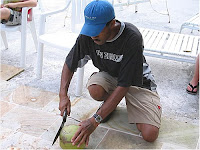Wise performs the Coconut Demonstration at Beqa Lagoon Resort, Fiji
During my stay at Beqa Lagoon Resort, Wise was kind enough to demonstrate to the guests how to husk a coconut by firmly thrusting it onto the sharpened end of a stout stick which was firmly planted in the ground. After piercing the husk, he then held the coconut against the stick with one hand and pressed downward with the other, separating off sections of husk. He repeated this motion until the entire husk was stripped off the coconut.
If you have ever looked at a coconut you will notice that all coconuts appear to have a face on them. First you notice the two "eyes", then you see one of three seams running between the "eyes." The point of the seams form a "nose," and the "mouth" is below the nose. While the area around the "eyes" is very hard, the "mouth" is the softest part of a coconut, even a dried one, and can easily be punctured by something sharp and thin. To crack the coconut open, you can use a rock, stick, or back of a heavy knife. Simply locate the seam that runs between the "eyes," turn the coconut sideways, and give it a good whack on the seam along the coconut's "equator." Of course, some or most of the relatively clear "juice" is going to spill out.
Normally, Fijians only drink the juice of young, sweet coconuts, which can sometimes develop a natural effervescence. To do this, they simply cut off the top of young green coconuts, without husking it. The sweet meat of the young coconuts makes for delicious eating and can be easily scraped out with a spoon. Mature white coconut meat, however, can be a half-inch thick and must be pried out of the shell. To do this safely use a dull knife, such as a butter knife, to slice into the thick meat, on an angle to the shell lip for an inch or two with a dull knife. Then using your wrist, twist the blade toward the lip of the shell, and a nice piece will pop out.
Once a feast has been made of the meat, the mature coconut flesh can be scraped out and squeezed for its oil, which is creamy and milky white in appearance, hence, the term coconut "milk." Then the left-over shreds can be given to the chickens or pigs.

 The coconut palm tree is used by the Fijians for more than just its coconut. The palm fronds are put to use for many purposes. Of course, as you know, fronds are used to thatch the roofs of the bures. They are also woven into mats, baskets, and decorative items. The fronds are also used to make the Fijian broom as seen above. The list is endless to the Fijian and that is why Wise passed down to us the wisdom of his ancestors, "Always be as wise and as useful as the coconut."
The coconut palm tree is used by the Fijians for more than just its coconut. The palm fronds are put to use for many purposes. Of course, as you know, fronds are used to thatch the roofs of the bures. They are also woven into mats, baskets, and decorative items. The fronds are also used to make the Fijian broom as seen above. The list is endless to the Fijian and that is why Wise passed down to us the wisdom of his ancestors, "Always be as wise and as useful as the coconut."English Fijian (pronunciation)
Smart Matai (mah tye)
I will be out of town for a few days and will resume my blog next Monday or Tuesday. Vinaka & Moce!



No comments:
Post a Comment